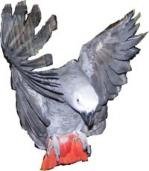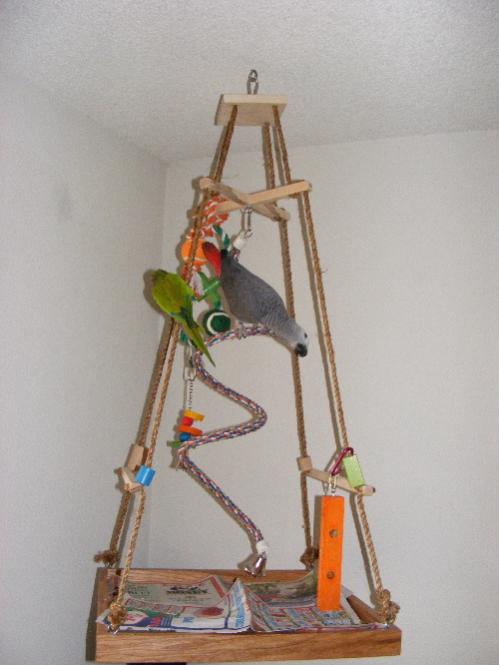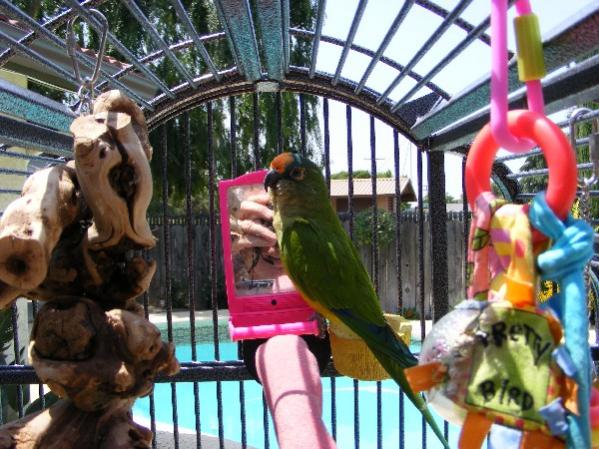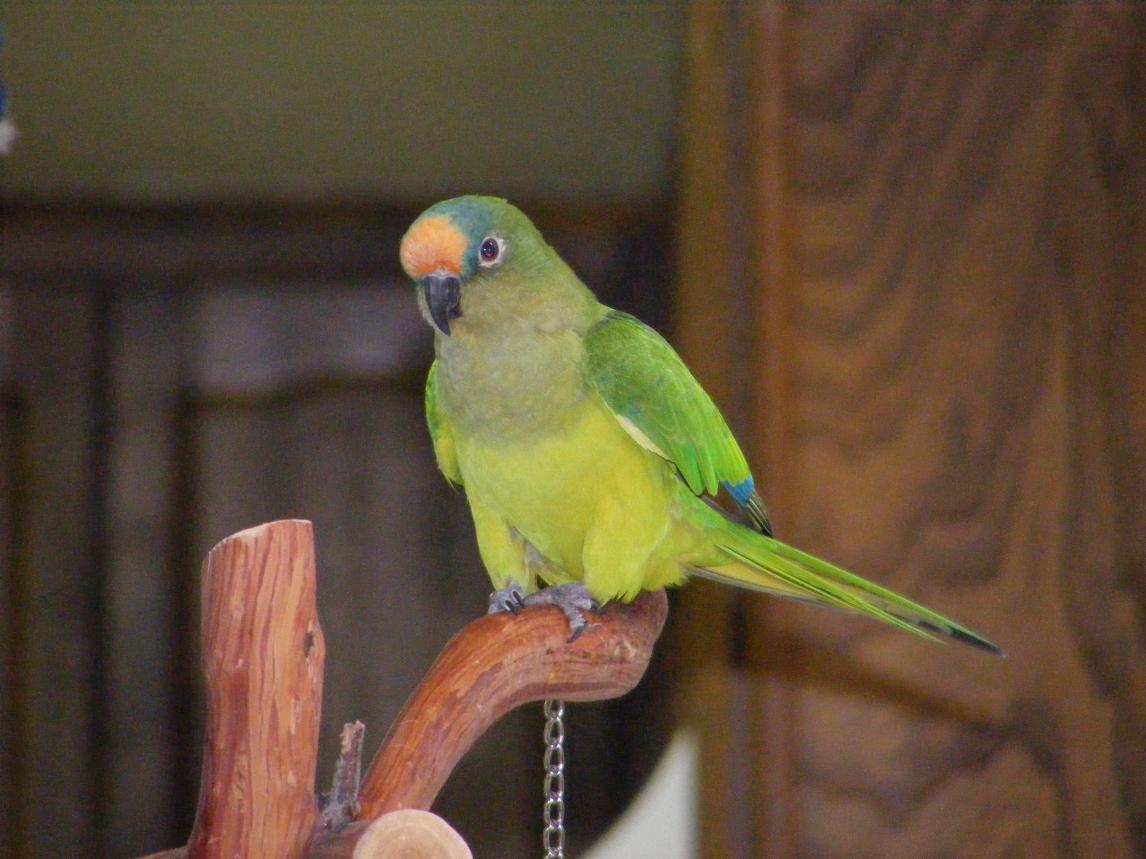NEW ADDRESS FOR MEMBERS GREYFORUMS.ORG
-
Posts
23,989 -
Joined
-
Last visited
Content Type
Profiles
Forums
Events
Gallery
Everything posted by danmcq
-
She is correcting you, not the other way around. She's does not want to step up for you and is letting you know that. Just watch her body language when you ask for a step-up and start moving your hand forward. She will lift her foot if she is gong to comply. It is too early for you to try and force it on her.
-
Hi and welcome to our forum! Your grey did not forget you. She is pissed about your leaving her and giving you the cold shoulder and playing hard to get. You are going to need to just have lots of patience, sit and talk to her, say things that you used to that you know she responded to etc. She will warm back up to you after she has made you suffer for it.... typical woman. Sorry, just had to add that to rouse some attention here.
-
"Fine!" LOL, I love Joey's personality!
-
Wow, thank god you found him! Your so spot on in regards being careful with a bird even if your bird is clipped... they can fly in many cases when startled.
-
Athena sounds like a real character! They are so full of themselves it is interesting just to watch them display all those characteristics. It's really surprising she doesn't care too much for baths or flying. But each one has it's own personality and likes. Jake jets around all over the place and must be with you wherever your going. If you take off with out him, you with hear bloody hell for it with screams and squawks. It's not but 30 seconds before you hear the sound barrier being broken as he flies to find and perch on you shoulder. Thanks for sharing this story about Athena. Now where's the photos and any videos you have?
-
It is natural for them to climb. Please snure you have plenty of padding on the bottom like towels in case a fall does occur. Also, please place perches low like 3 inches off the bottom so you baby can get used to perching on them and place food and wate bowls on the bottom as well for now.
-
I use 1 cup of apple cider vinegar to each gallon of water. I slosh them around for 2 minutes, then rinse them thoroughly with water afterwards.
-
I would also like to add one more warning to this discussion. Humans and parrots can get some nasty bacterial infections sometime causing death from unwashed vegetables and fruits. Please ensure when feedings raw vegetables or fruits to your parrot, that you thoroughly wash them in a vinegar/water solution to remove/destory all bacterial contamination and any residual pesticides. Also, as Nancy preaches, wash your hands, especially after handling any raw meats or vegetables.
-
Hello Brooke, After considering all that you have written on where you are in your life and where you are going education and career wise. Itruly believe the tiiming and circumstances are not well suited to taking on an african grey or other medium to large size parrot. With the class schedule, studies and time required to intern etc. and the 12 plus hour shifts nursing requires, you should truly wait until your life has stabilized and you know without a doubt your on your won, have the room, the time and the money to probably care for an african grey. Once you are in that stable condition, I have no doubt you would be a great parrot owner.
-
Thanks Steve! OK, lets just put this to bed. Both humans and parrots mouth/beaks are Gram Positive in a completely sterile case. However, eating most anything can introduce gram negative bacteria. Rather than stating any of my own thoughts on this, I will post an article by a certified veterinarian doctor: Bacterial Issues in Pet Parrots This was a question from a client. I felt that I should address the subject of bacteria in pet parrots, as there is a lot of confusion on interpretation of cultures in parrots. Question: My quaker recently died from a cause that left me shocked. My avian vet informed me that the cause of death is the most common for all pet birds and is one that is easily avoidable. It is E. coli infection, from the same E. coli that is indigenous to the human digestive system. How do birds get this infection? By our kissing and cuddling them. My quaker, Mr. Tzip, used to say: "I love you" while giving me birdie kisses and would steal carrots from my mouth. I had no idea he would pick up a fatal infection from this. I know we all love our birds but I also know that none of us would want to do anything harmful to them. That is why I am writing this letter. Answer: Please let me offer my condolences about the loss of you pet quaker parakeet. Losing a dear feathered friend is always a tragedy, and if you feel somehow responsible, it seems to make it so much worse. Let me teach you and my readers about bacterial infections in birds and Escherichia coli, aka E. coli., specifically. That may, in some way, assuage your guilt. So, what exactly is E. coli? We hear that name tossed around a lot these days, often in relation to food borne outbreaks from contaminated food products, such as hamburger meat, unpasteurized apple juice or cider, salad, salami or unpasteurized milk. E. coli is a Gram negative bacterium in the Enterobacteriaceae family. There are many harmless or even beneficial strains of E. coli that occur widely in nature. E. coli is the predominant non-pathogenic (non-disease-causing) facultative anaerobic (can live and multiply with or without the presence of oxygen) member of the human intestinal microflora. Some strains can cause disease of the gastrointestinal tract, urinary tract and central nervous system in humans. Interestingly, the intestinal tracts of almost all birds (including some parrot species, especially cockatoos and Eclectus) and mammals, including non-human primates and horses are colonized by E. coli. Birds, especially psittacines, are less dependent on E. coli and rely more on Gram positive gut bacteria. However, softbills, including finches, songbirds and jays, pigeons and doves, poultry, waterfowl, raptors and ratites all have a high incidence of normal Gram negative bacteria in the gastrointestinal tract, including many strains of E. coli. These bacteria usually live quite benignly in the GI tract of these animals and birds, with no untoward consequences. E. coli can comprise up to 30% of the bacterial flora in some psittacines, and other species, including cockatiels and budgerigars, still have some E. coli, just lesser amounts. However, some strains of E. coli are among the most common bacterial pathogens responsible for diarrheal diseases in humans, especially children and those with less-than-optimal immune systems. Many cases of infant diarrhea in developing countries are caused by pathogenic strains of E. coli that cause toxin formation or that invade and destroy bowel mucosa. One very serious strain goes by the serotype: O157:H7, which causes diarrhea, copious bloody discharge and no fever. This strain produces a toxin that affects the kidneys, and can result in acute renal failure, especially in infants. In humans, this strain is often associated with the ingestion of inadequately cooked hamburger meat. E. coli can certainly be responsible for causing all sorts of infections in psittacine birds, and can even penetrate through the pores in egg-shells, resulting in dead-in-shell embryos or death of recently hatched chicks. E. coli is identified as one of the most common causes of infection of the oviduct and reproductive tract in parrots. I think it is safe to say that E. coli is a quite common bacterial organism, found in human mouths (25% of the time, anyway), it is found in dog and cat feces, manure used to fertilize produce and flowers, and it is found in the gastrointestinal tract of many animals we interact with on a daily basis. MOST of the time, it is harmless, and causes no problems whatsoever. However, a pathogenic strain may find its way into produce from the grocery store that has not been thoroughly rinsed, so when it is fed to a bird, it may result in serious, life-threatening or even fatal disease. A dangerous strain, such as O157:H7 would likely cause a human to become ill, but many healthy adult humans exposed may be able to mount an effective immune response. This strain won't be commonly found in a healthy human mouth. Any time E. coli is found on a culture from other than the intestinal tract of a bird, it should be considered pathogenic. E. coli has the ability to proliferate uncontrollably outside of its normal home territory of the GI tract. But, some strains of E. coli can also cause gastrointestinal disease and diarrhea, often dangerous and potentially fatal, if not identified and treated in time. How is E. coli diagnosed? Most commonly, it will be isolated and cultured from the bird, and then the lab will perform antibiotic sensitivity tests, to ascertain which antibiotics are most likely to succeed in treating this infection. Support care, including kaolin and pectin or bismuth subsalicylate, fluid therapy, supplemental heat and nutrition are all important to help care for the bird. Other tests, including a DNA PCR for identifying these bacteria, and sophisticated assays involving biochemical reactions, can also be performed. It may be possible to get a basic idea if E. coli could be the culprit in some isolates by assessing which antibiotics the organism is susceptible to. Blood tests to measure blood chemistries and also to check the complete blood count, including white blood cell count and differential are often helpful in determining if an infection caused by bacteria is present. Specific antibiotic therapy can successfully eliminate the bacteria from a bird's system, however, the organisms can survive in dried droppings and contaminated dander for quite a long time. So, clean up and disinfection of the bird's environment is mandatory. Bacterial cultures in birds should never be used solely as a diagnostic method. These tests must also be evaluated in light of the physical examination, history, diet and other tests, most importantly the CBC, especially the white blood cell count (WBC). If the WBC is within the normal range and the differential (the percentages of the different white blood cells) is normal, then the bacteria may be "just passing through" and not the primary source of the problem. It is very important that avian vets learn the subtle differences between the differentials of the different parrots, as some have the heterophil as the primary white blood cell, others have the lymphocyte as the primary white blood cell, and yet others often have about equal numbers of hets and lymphocytes. So, bottom line... do I think that your actions caused the death of your bird? No. However, I wasn't there, I didn't examine or treat your bird. And I never recommend allowing a bird to take food from a human's mouth, or share silverware, because we do harbor potentially dangerous bacteria for pet birds. But, it doesn't sound like you are responsible for your bird acquiring a fatal E. coli infection, if that is what it died from. Just because an organism is cultured from a bird's cloaca, that doesn't unequivocally mean that is what killed it. Many organisms harmlessly pass through the GI tract of pet birds every day, causing little or no problem. I just want you to understand that there can be many causes of death of a pet bird, not always what appears to be the most obvious. Copyright © 2009 Margaret A. Wissman, D.V.M., D.A.B.V.P. All Rights Reserved ExoticPetVet.net www.exoticpetvet.net
-
Showering every day would not be good for your grey, as your vet said. Every other day may be ok, but you need to start drenching your grey with 100 percent Aloe Juice from a misting bottle after you have showered him. This will help make soft and ease the itching.
-
I think the author of the book is spot-on. Did you have any other questions on weaning besides if the author was correct in their statements regarding to refrain from sharing items between human/parrot mouth/beak?
-
I got Jake about 8 years ago from a shady guy in San Jose that had cages of parrots in his backyard. He had everything from Macaws to Conures. Jake was over on the side of the house in 1 x 2 foot tiny cage sitting on a self nail to the fence and the guy claimed he was tame... There was no doubt in my mind after watching Jake flap around while this moron used a glove to grab him and quickly place him in a little cardboard box that he was in no way socialized or even used to people. I truly suspect he is an illegal wild caught Conure, no band the guy was a liar and just wanted a quick 75 bucks for a bird that normally goes for 275 to 300 from a breeder. Long story short, it took at least a year to get jake to show any interest in us or to step up. I did (much to my disliking and better judgement) clip his wings which left him with no choice but to step up (while biting) to get off the floor which he would flap down to. First I used a small perch to have him step up while moving my hand over time closer and closer to him, so he would get the idea that no harm was going to come to him. Once it got to the point he pretty much started beaking my hand because it was so close to him one inch on the perch, I quit using and started offering my hand only, which he would reluctantly climb on to. After 2 years, he was actually starting to talk saying "Hello" much to my shock. Today 7 years later he has a limited vocabulary of hello, pretty boy, how are you and some thing that sounds kind of like apple. His main communication is a loud screech and/or squawk for a contact call, let me out of this cage now or where the hell are you. He loves baths ( as most do) and showers. If he doesn't get one in two days he will use his water bowl do drench himself. He now shoulder rides everywhere, steps up and loves to sit perched on my wife's or my shoulder snuggled up against our cheek or directly under our chin while watching tv and loves scratches as well. I think this shows a little insight in to how long a journey getting a new abused/wild caught parrot can be to get them to the point of accepting a human flock with their little heart and mind as their flock that will protect and provide for them unconditionally. Jake wanting a bath and Dayo trying his damnedest to stop him video:
-
They are so vulnerable and cute when that young. Touching photos! It is wonderful you are able to go and visit them and that you have first pick. You will be shocked at how fast the change week to week. It will also give you time to see which one wnats you over time as you visit and comes running when they see you. It is always wonderful when you have the opportunity to let them pick you.
-
That is a wonderful step forward. You two are building a great relationship. Thanks for sharing this.
-

hello form a new grey owner from the uk
danmcq replied to naya's topic in Welcome & Introduction Room
Welcome Naya and thanks for taking in a grey in need of a home. It will take a few days ro weeks to settle in and get used to the new surroundings and family. Looking forward to hearing more and seeing photos and videos. -
Welcome Bigmick and Charlie. He is a fine looking Timneh. It sounds like you are off to a good start and Charlie is settling right in. As you go, you will have more to share about his progress and any questions or comments about his behavior. We will be looking forward to hearing much more.
-
There are literally dozens of different types of Conures and they each offer something different to the pet bird owner. Conures are lightly built, with long tails (Conure literally means 'cone tail') . They come in a diverse range of colors. Conure beaks always have a small cere and are usually horn-colored or black.They reach maturity at 1 to 3 years, the smaller Conures mature more quickly. In a safe, healthy environment, they can expect to live up to 25 - 35 years. Personality / Pet Potential Conures are clowny birds, have a great fun-loving personality, think they can take on another bird 10 times their size and are lion hearted. Conures, in general, love to snuggle under things, so providing them with a tightly woven wash cloth, soft piece of fabric, or fuzzy toy will be appreciated. A bird tent as a place to sleep is normally welcomed. They also love to go into dark places such as cabinets, or into the smallest nook or cranny they discover. So if you can't find your conure, start looking in cabinets (they sneak in while open and will not let out a peep when you close the door) or in the smallest of of openings they cold fit into. Conures can be VERY noisy and can also be nippy delivering a good bite for such a little bird. They make great birds for those who don't mind the occasional (or NOT so occasional) screeching outburst. This is something to be considered when thinking of adding a conure to your family. Conures do require more time and effort than say a tiel or budgie. Please keep this in mind. Many conure lovers report that they are smart and interactive, but are also more prone to behavioral problems than are tiels or budgies, but this would be the case with any conure. They all require a committed owner who will work with their pets to guide their behavior, while tiels and budgies are "beginner birds." They are very active parrots that like to play, explore and chew. Lots of toys are recommended to keep their beaks from "getting busy" on your furniture.Most conures absolutely love water and a drenching bath up to 3 times a week. Diet They enjoy a good seed mix and fruit along with a small portion of nuts. Because of the conure's susceptibility to Conure Bleeding Syndrome (CBS), it is recommended that a conure's diet should contain foods high in calcium and Vitamin K, including dark leafy greens and vegetables (i.e., kale, broccoli), carrot tops, alfalfa, tomatoes, egg yolk, soy oil, and fish meal. Alternatively, a high-quality pelleted diet could be provided. Types of Conures - by genera: Aratinga Conures There are many conure birds in the Aratinga genus, it contains about 25 species and many subspecies. This genus also includes some of the most popular conures, such as the Sun Conure Jenday Conure. Peach-fronted Conure, Red-masked Conure, Mitred Conure, and more. Aratinga Conures are found across a large area of Central and South America, from Mexico to central Argentina as well as in the West Indies. Within this huge range, their habitats vary from tropical rainforests to savannahs, deserts to semi- deserts, and from mountains to sea level. Nandayus Conures The Nandayus genus consists of one species, Nandayus nenday. It has a variety of common names including Nanday Conure, Nanday Parakeet, Black-hooded Conure, and Black-masked Conure. The Nanday Conure is native to southeastern Bolivia, southern Mato Grosso, northern Argentina, Chaco Formosa, and Paraguay. It has also been introduced into North America, with colonies reported in the southern and eastern parts of the United States. Ognorhynchus Conures The Ognorhynchus genus consists of one species, Ognorhynchus icterotis, called the Yellow-eared Conure or Yellow-eared Parrot. It is an endangered species from the western Andes of Colombia. Leptosittaca Conures The Leptosittaca genus consists of one species, Leptosittaca branickii, called the Golden-plumed Conure or Golden-plumed Parrot. It is found widely but locally distributed in Colombia, but numbers are in declining due to habitat destruction. Conuropsis Conures (Extinct -Sad) Cyanoliseus Conures The Cyanoliseus genus consists of the nominate species, Cyanoliseus patagonus, called the Patagonian Conure or Burrowing Parrot, and 3 subspecies. It is found in Argentina and Chile, with some migration population found in Uruguay in the winter. Enicognathus Conures The genus Enicognathus has two species, and a few subspecies. The familiar conure species are the Slender-bill Conure, Astral Conure, and the Chilean Conure. They are found in Chile, southern Argentina, and the islands in the Strait of Magellan. They inhabit mostly in wooded country, but can also be found in shrubland and farmland. Pyrrhura Conures The genus Pyrrhura consists upwards of 22 species and a number of subspecies. This genus includes the smallest conure parrot, the Painted Conure, as well as some other well-known conures including the Green-cheeked Conure, Black-capped Conure, Pearly Conure, Souance Conure, and more. Pyrrhura Conures are found in Panama and Costa Rica of southern Central America and in South America, inhabiting tropical and subtropical regions. Some species are highly endangered.
-
Nice intro Dee! I look forward to hearing and seeing more post about this wonderful species.
-
I did a poll a few year back on this. The predominant age for Congo's is 12 to 14 months. As Jeff stated, TAGs seem to start earlier. Please note, regardless of what age they start talking is no reflection of how vast their vocabulary will become. Also, some may never talk as stated previously as well. Many never really know when they first start talking because they will sit when no one is around and calibrate in a very low voice until they feel they have mastered down to the last frequency cycle a perfect reflection of how it was said. They for the most part have been talking long before you are ever aware of it.
-
Like Ray, first red canary I have seen as well. Thanks for sharing this!
-
:mad: Oh Jesus, bastards!!!
-
Poor baby, getting frightened at night is traumatic. Yes, birds are the masters of feather care. He will starighten this out on his own in his own timing.
-
Brutus is coming along nicely and now enjoying watching you hop through the hoops now that he has figured out he can turn the tables and requests things as well. Thanks for sharing this.
-
Jay and Talon have given good advice and asked pertinent questions regarding our Grey. The more you can post and describe what you are going through with your re-homed grey, the better off you will both be if the answer are applied and followed. It takes a ton of patience and commitment in some cases if with such a young grey at 3 years old.




